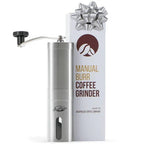There’s more to tasting coffee than just the flavors and aromas. Mouthfeel can contribute to our coffee experience dramatically, though we rarely think that the way our coffee feels is something worth considering.
But mouthfeel is definitely worth considering.
Coffee can be crisp. It can be clean. It can be smooth, creamy, juicy. Being able to perceive these differences is rewarding, especially when a particularly sweet and juicy coffee comes around and takes your tongue to mouthfeel paradise.
This is part of our Coffee Tasting Series. If you haven’t read the first few blogs about tasting coffee, I highly suggest you start from the beginning.
If you’re all caught up, allow me to teach you to feel your coffee.
What Mouthfeel In Coffee Is Made Of
To best understand how to perceive and describe a coffee’s mouthfeel, you must first learn what the feelings are made of. Even though 97% of black coffee is just plain water, there’s other stuff as well - and it’s these things that create the mouthfeel.
When you brew your coffee, the water extracts things out of the coffee grounds and dissolves them. We call these things solubles. Coffee solubles include fats, proteins, sugars. acids, caffeine, carbohydrates, and some fibers. Even though these compounds dissolve, they still give the water a slightly different feeling than it had before (and add flavor, of course).
You also get some undissolved solids, such as tiny microscopic coffee particles that break off from bigger grounds. These micro-particles release their solubles in the water, but the fibers and carbohydrates that make up the ground’s structure remain intact and undissolved. If you get enough of them in your cup, you can literally feel them.
Read: Blades VS Burrs: What Is the Best Type of Coffee Grinder?
Lastly, there are the coffee’s natural oils. If you remember from science class, oils and water don’t combine to form a single solution. They remain separate to form a mixture, and you can sometimes feel the different layers of your coffee.
Now that you have the building blocks of mouthfeel (and flavor, acidity, and everything else) in mind, let’s talk about describing them.
How To Describe Coffee Mouthfeel
Before we move on, it’s important to remember that coffee generally has a heavier body than many of the other liquids we drink. When we describe a coffee as having a “light mouthfeel”, we say it in relation to other coffee, but not compared to water or tea or soda.
Here are some of the more common ways we describe a coffee’s body or mouthfeel in the specialty coffee world.
Light - A light bodied coffee is pretty common. These coffees have fully developed and well rounded flavors without feeling very thick or heavy. Because of the lighter body, they often seem slightly easier to drink.
Thin - This descriptor is similar to light, but usually generates a negative connotation. A coffee with a thin mouthfeel or body is probably too light and feels like there should be more there.
Read: How To Pair Your Coffee Brewer With Its Perfect Grind Size
Heavy or Full - Coffees with a heavy mouthfeel are also quite common. These coffees simply feel full. They feel heavy. Each sip feels like it has a lot of substance and umph to it (typically along with a lot of flavor).
Medium - Most of the world’s coffee falls somewhere in the middle of the road. The mouthfeel is there, but it doesn’t really lean one way or the other too much. Though they aren’t as exciting mouthfeel-wise, these are by no means bad coffees or any less flavorful.
Creamy or Silky - A creamy mouthfeel can be light or heavy, but I find most often that they feel heavier. When you swish a creamy coffee around your mouth, it feels slightly more saucey. Imagine how milk glides around your tongue - it’s in that direction.
Juicy - Juicy coffees are quite distinct and are some of my favorites. When you take a sip of a juicy coffee, you can instantly feel the light brightness of it. This feeling is often due to a high concentration of sugars (just like juice) and oils, and is usually accompanied by a refreshing sweetness.
Astringent - A feeling of dryness on your tongue. Coffees that are under extracted or that have a high level of acidity can cause this feeling.
Some people find mouthfeel to be a stressful thing. Don’t stress out! These are pretty basic terms, so you already know what they feel like. Once you experience a couple of them in coffee, you’ll pick up how they feel different pretty quickly.
Read: What Does A Coffee Roaster Actually Do?
The Effect Of Brewing Methods On Mouthfeel
The way you brew your coffee has a massive impact on your coffee’s mouthfeel. Though you can’t turn a juicy coffee into a heavy one like magic, you can slightly alter it to fit your preferences.
Immersion VS Pour Over Brewing
Immersion brewers like the French Press, Aeropress, Clever allow the coffee grounds and water to sit together for a period of time before being manually filtered some way or another. This period of immersion tends to break off extra micro-grounds from the coffee grounds, causing the body to be on the heavier and creamier side.

Pour over coffee brewers such as the JavaPress Pour Over Dripper, Chemex, and Hario V60 allow the water to drain as quickly as gravity and the coffee ground bed will allow it to. Since each water particle spends less time interacting with the coffee grounds, the mouthfeel is often a bit thinner and juicier.
These aren’t objective rules that you can always rely on. Sometimes pour over coffee is thick and creamy, and sometimes coffee from a French Press is still too thin. But generally, immersion brewing produces a heavier mouthfeel than pour over brewers.
Your Coffee Filter Type
The type of coffee filter you use also plays a big role in how your coffee feels.
Paper filters absorb some of the coffee oils and hold back most of the undissolved solids and micro-particles. Chemex filters are thick and heavy, so coffee made in a Chemex usually has a very light body. The Hario V60’s filters are thinner and allow a small amount of the oils get through, but the end result is still on the light side. Since the acids can get through paper, but not micro-grounds, coffee made with paper filters often feels brighter and more acidic.
Cloth filters allow most of the oils to pass right through, but do a great job at keeping undissolved solids from entering your final mug. Coffee from these filters can be light or heavy, depending on the coffee. The high concentration of oils without the micro-grounds, can feel quite smooth and creamy.
Read: The Differences Between Paper, Cloth, And Metal Coffee Filters
Metal filters, in many ways, take the cake. They allow all of the coffee’s natural oils to get through, as well as some microscopic micro-grounds (depending on the size of the filter’s holes). This combination of oils, acids, other solubles and micro-grounds allows you to experience the full realm of flavor and produces a full body that can also be creamy or juicy.
We’re major fans of the full flavor and body that metal filters provide at JavaPresse, which is why we’ve made our own brewers to feature them. We have nothing against paper or cloth, but the richness that metal filters produce is unmatched.
---
You’re now aware of a new realm of coffee experiences that make the world of coffee a little richer and more diverse. I think you’ll enjoy your newfound skill.
Put your new skill to the test with specialty-grade, freshly roasted beans or you risk losing what you've just read.
If you find yourself struggling to describe a coffee’s mouthfeel, ask the magic tasting question: What does this remind me of?
We’re almost finished with the Coffee Tasting Series, and the final blog is going to take everything you’ve learned so far and bring it all together.
Up next: Aftertaste.
Happy feeling!


